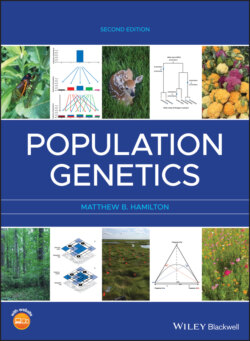Читать книгу Population Genetics - Matthew B. Hamilton - Страница 2
Table of Contents
Оглавление1 Cover
2 Title Page
3 Copyright Page
4 Dedication Page
5 Preface and acknowledgements
6 About the companion websites
7 CHAPTER 1: Thinking like a population geneticist 1.1 Expectations 1.2 Theory and assumptions 1.3 Simulation Chapter 1 review Further reading
8 CHAPTER 2: Genotype frequencies 2.1 Mendel's model of particulate genetics 2.2 Hardy–Weinberg expected genotype frequencies 2.3 Why does Hardy–Weinberg work? 2.4 Applications of Hardy–Weinberg 2.5 The fixation index and heterozygosity 2.6 Mating among relatives 2.7 Hardy–Weinberg for two loci Chapter 2 review Further reading End‐of‐chapter exercises
9 CHAPTER 3: Genetic drift and effective population size 3.1 The effects of sampling lead to genetic drift 3.2 Models of genetic drift 3.3 Effective population size 3.4 Parallelism between Drift and mating among relatives 3.5 Estimating effective population size 3.6 Gene genealogies and the coalescent model 3.7 Effective population size in the coalescent model 3.8 Genetic drift and the coalescent with other models of life history Chapter 3 review Further reading End of chapter exercises
10 CHAPTER 4: Population structure and gene flow 4.1 Genetic populations 4.2 Gene flow and its impact on allele frequencies in multiple subpopulations 4.3 Direct measures of gene flow 4.4 Fixation indices to summarize the pattern of population subdivision 4.5 Population subdivision and the Wahlund effect 4.6 Evolutionary models that predict patterns of population structure 4.7 Population assignment and clustering 4.8 The impact of population structure on genealogical branching Further reading End of chapter exercises
11 CHAPTER 5: Mutation 5.1 The source of all genetic variation 5.2 The fate of a new mutation 5.3 Mutation models 5.4 The influence of mutation on allele frequency and autozygosity 5.5 The coalescent model with mutation Further reading End‐of‐chapter exercises
12 CHAPTER 6: Fundamentals of natural selection 6.1 Natural selection 6.2 General results for natural selection on a diallelic locus 6.3 How natural selection works to increase average fitness 6.4 Ramifications of the one locus, two allele model of natural selection Further reading End‐of‐chapter exercises
13 CHAPTER 7: Further models of natural selection 7.1 Viability selection with three alleles or two loci 7.2 Alternative models of natural selection 7.3 Combining natural selection with other processes 7.4 Natural selection in genealogical branching models 7.5 Shifting balance theory Further reading End‐of‐chapter exercises
14 CHAPTER 8: Molecular evolution 8.1 The neutral theory 8.2 Natural selection 8.3 Measures of divergence and polymorphism 8.4 DNA sequence divergence and the molecular clock 8.5 Testing the molecular clock hypothesis and explanations for rate variation in molecular evolution 8.6 Testing the neutral theory null model of DNA sequence polymorphism 8.7 Recombination in the genealogical branching model Further reading End‐of‐chapter exercises
15 CHAPTER 9: Quantitative trait variation and evolution 9.1 Quantitative traits 9.2 Evolutionary change in quantitative traits 9.3 Quantitative trait loci (QTL) Further reading End‐of‐chapter exercises
16 CHAPTER 10: The Mendelian basis of quantitative trait variation 10.1 The connection between particulate inheritance and quantitative trait variation 10.2 Mean genotypic value in a population 10.3 Average effect of an allele 10.4 Breeding value and dominance deviation 10.5 Components of total genotypic variance 10.6 Genotypic resemblance between relatives Further reading End‐of‐chapter exercises
17 Appendix A.1 Covariance and Correlation Further reading
18 Bibliography
19 Index
20 End User License Agreement
